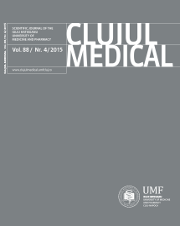THE ROLE OF KETAMINE IN THE TREATMENT OF CHRONIC CANCER PAIN
DOI:
https://doi.org/10.15386/cjmed-500Keywords:
ketamine, cancer pain, pain treatment, chronic cancer pain treatment, neuropathic pain.Abstract
Background and aim. Ketamine is a drug used for the induction and maintenance of general anesthesia, for the treatment of postoperative and posttraumatic acute pain, and more recently, for the reduction of postoperative opioid requirements. The main mechanism of action of ketamine is the antagonization of N-methyl-D-aspartate (NMDA) receptors that are associated with central sensitization. In the pathogenesis of chronic pain and particularly in neuropathic pain, an important role is played by the activation of NMDA receptors. Although ketamine is indicated and used for the treatment of chronic cancer pain as an adjuvant to opioids, there are few clinical studies that clearly demonstrate the effectiveness of ketamine in this type of pain.
The aim of this study is to analyze evidence-based clinical data on the effectiveness and safety of ketamine administration in the treatment of chronic neoplastic pain, and to summarize the evidence-based recommendations for the use of ketamine in the treatment of chronic cancer pain.
Method. We reviewed the literature from the electronic databases of MEDLINE, COCHRANE, PUBMED, MEDSCAPE (1998-2014), as well as chapters of specialized books (palliative care, pain management, anesthesia).
Results. A number of studies support the effectiveness of ketamine in the treatment of chronic cancer pain, one study does not evidence clear clinical benefits for the use of ketamine, and some studies included too few patients to be conclusive.
Conclusions. Ketamine represents an option for neoplasic pain that no longer responds to conventional opioid treatment, but this drug should be used with caution, and the development of potential side effects should be carefully monitored.
Downloads
Published
How to Cite
Issue
Section
License
The authors are required to transfer the copyright of the published paper to the journal. This is done by agreeing to sign the Copyright Assignment Form. Whenever the case, authors are also required to send permissions to reproduce material (such as illustrations) from the copyright holder.

The papers published in the journal are licensed under a Creative Commons Attribution-NonCommercial-NoDerivatives 4.0 International License.

